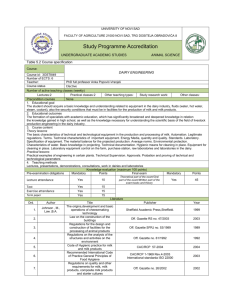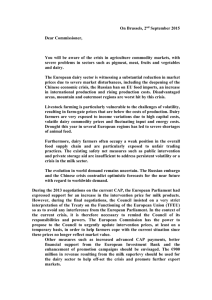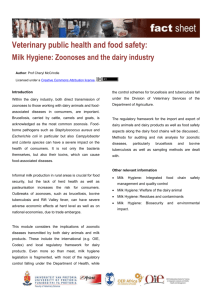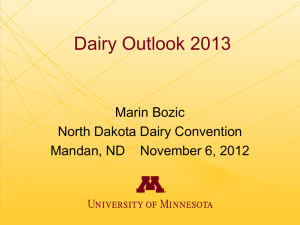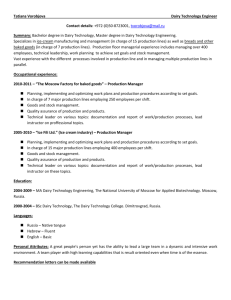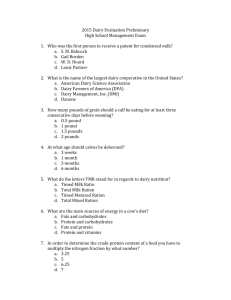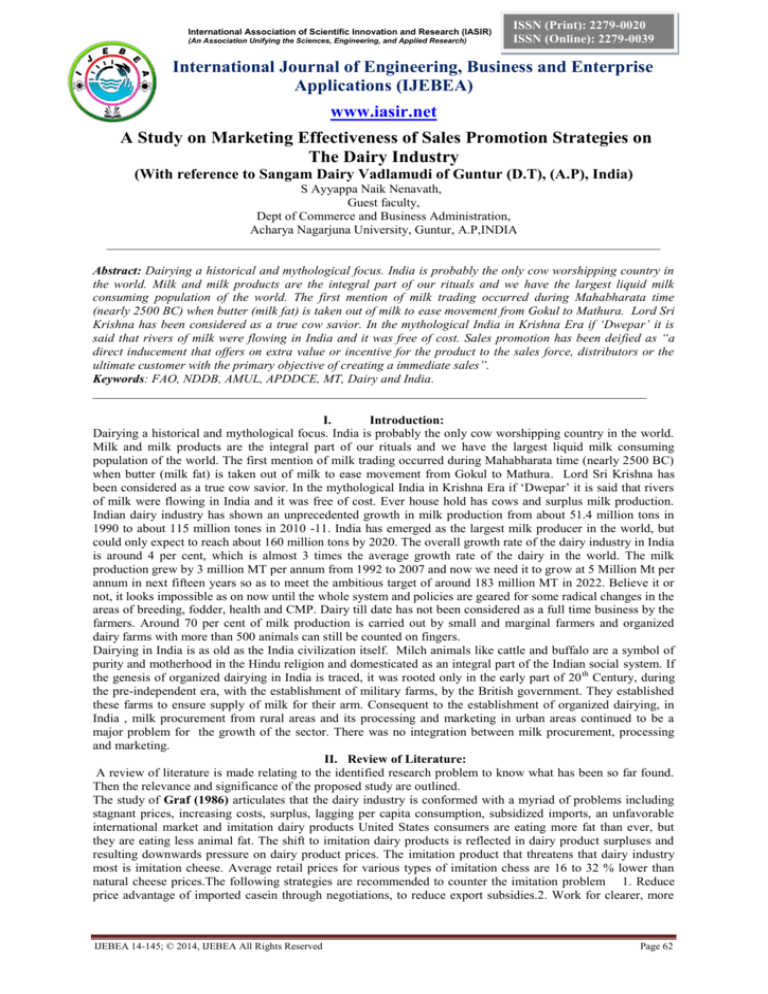
International Association of Scientific Innovation and Research (IASIR)
(An Association Unifying the Sciences, Engineering, and Applied Research)
ISSN (Print): 2279-0020
ISSN (Online): 2279-0039
International Journal of Engineering, Business and Enterprise
Applications (IJEBEA)
www.iasir.net
A Study on Marketing Effectiveness of Sales Promotion Strategies on
The Dairy Industry
(With reference to Sangam Dairy Vadlamudi of Guntur (D.T), (A.P), India)
S Ayyappa Naik Nenavath,
Guest faculty,
Dept of Commerce and Business Administration,
Acharya Nagarjuna University, Guntur, A.P,INDIA
______________________________________________________________________________________
Abstract: Dairying a historical and mythological focus. India is probably the only cow worshipping country in
the world. Milk and milk products are the integral part of our rituals and we have the largest liquid milk
consuming population of the world. The first mention of milk trading occurred during Mahabharata time
(nearly 2500 BC) when butter (milk fat) is taken out of milk to ease movement from Gokul to Mathura. Lord Sri
Krishna has been considered as a true cow savior. In the mythological India in Krishna Era if ‘Dwepar’ it is
said that rivers of milk were flowing in India and it was free of cost. Sales promotion has been deified as “a
direct inducement that offers on extra value or incentive for the product to the sales force, distributors or the
ultimate customer with the primary objective of creating a immediate sales”.
Keywords: FAO, NDDB, AMUL, APDDCE, MT, Dairy and India.
______________________________________________________________________________________
I.
Introduction:
Dairying a historical and mythological focus. India is probably the only cow worshipping country in the world.
Milk and milk products are the integral part of our rituals and we have the largest liquid milk consuming
population of the world. The first mention of milk trading occurred during Mahabharata time (nearly 2500 BC)
when butter (milk fat) is taken out of milk to ease movement from Gokul to Mathura. Lord Sri Krishna has
been considered as a true cow savior. In the mythological India in Krishna Era if ‘Dwepar’ it is said that rivers
of milk were flowing in India and it was free of cost. Ever house hold has cows and surplus milk production.
Indian dairy industry has shown an unprecedented growth in milk production from about 51.4 million tons in
1990 to about 115 million tones in 2010 -11. India has emerged as the largest milk producer in the world, but
could only expect to reach about 160 million tons by 2020. The overall growth rate of the dairy industry in India
is around 4 per cent, which is almost 3 times the average growth rate of the dairy in the world. The milk
production grew by 3 million MT per annum from 1992 to 2007 and now we need it to grow at 5 Million Mt per
annum in next fifteen years so as to meet the ambitious target of around 183 million MT in 2022. Believe it or
not, it looks impossible as on now until the whole system and policies are geared for some radical changes in the
areas of breeding, fodder, health and CMP. Dairy till date has not been considered as a full time business by the
farmers. Around 70 per cent of milk production is carried out by small and marginal farmers and organized
dairy farms with more than 500 animals can still be counted on fingers.
Dairying in India is as old as the India civilization itself. Milch animals like cattle and buffalo are a symbol of
purity and motherhood in the Hindu religion and domesticated as an integral part of the Indian social system. If
the genesis of organized dairying in India is traced, it was rooted only in the early part of 20 th Century, during
the pre-independent era, with the establishment of military farms, by the British government. They established
these farms to ensure supply of milk for their arm. Consequent to the establishment of organized dairying, in
India , milk procurement from rural areas and its processing and marketing in urban areas continued to be a
major problem for the growth of the sector. There was no integration between milk procurement, processing
and marketing.
II. Review of Literature:
A review of literature is made relating to the identified research problem to know what has been so far found.
Then the relevance and significance of the proposed study are outlined.
The study of Graf (1986) articulates that the dairy industry is conformed with a myriad of problems including
stagnant prices, increasing costs, surplus, lagging per capita consumption, subsidized imports, an unfavorable
international market and imitation dairy products United States consumers are eating more fat than ever, but
they are eating less animal fat. The shift to imitation dairy products is reflected in dairy product surpluses and
resulting downwards pressure on dairy product prices. The imitation product that threatens that dairy industry
most is imitation cheese. Average retail prices for various types of imitation chess are 16 to 32 % lower than
natural cheese prices.The following strategies are recommended to counter the imitation problem 1. Reduce
price advantage of imported casein through negotiations, to reduce export subsidies.2. Work for clearer, more
IJEBEA 14-145; © 2014, IJEBEA All Rights Reserved
Page 62
S Ayyappa Naik Nenavath, International Journal of Engineering, Business and Enterprise Applications, 7(1), December 2013- February
2014, pp. 62-66
prominent labeling of imitation dairy products. 3. Put more emphasis on better margin blend products, which
compete more directly with margarine than butter. 4. Use more of the annual promotion funds from farmer
check offs for promoting cheese.
Acharya. R. M (2009) felt that to ensure that buffalo production should be economically sound and socially
satisfying. There is a need for improvement of production, improvement in methods of handling milk at the
source of production and improvement in economic returns from disposal of milk of live animals for breeding,
draught or meat.
Ezhil Raj. R., Safiullah. A. Md., Selvam. S., Annal Villi. R., Senthilkumar. V (2009) says that Production of
dairy tends to be region specific. In the production and marketing of indigenous dairy products, there exist
various cost components. The present study done at Uthukuli block in Erode district of Tamil Nadu, famous for
butter and curd making, aims to analyze the production of butter in economic term.
Suresh, R (2009) assumed that Milk and milk products undeniably have great potential both as a source of
precious nutrients and as the basis for functional foods that will contribute substantial health benefits to the
consumers. Functional foods have vast potential and are going to be the mega-trends of the future in dairy
products beginning with metro-markets and gradually spreading to other big cities and towns.
The Indian Dairy Association 2010 (east zone) in association with the Bihar State Co-operative Milk
Producers Federation (Compfed) organized a seminar on dairy development in eastern India focusing on the
impact of natural calamities on milk production. The seminar also reviewed the giant leap taken by the
federation in producing a record quantity of milk and milk products against all odds.
III. Objectives and Methodology
Need for the study:
Today dairying industry has become permanent phenomenon along with the manufacturing industry.
Revolutionary changes have taken place in the dairy Industry right from the procurement at the gross root level
from the farmer, processing and preservation and distribution of the same unto the ultimate customers, taking
the unprecedented experiment of Anand, Gujarat as a model. In the process, lot of problems have to be faced by
the farmer, collection centers, issues involved at the factory regarding strategies related to sales promotion.
Against this back ground, an attempt is made in this study to make an in depth enquiry in to all the identified
issues of Dairy marketing in a scientific manner.
Hypotheses:
It is also further hypothesized that the present strategy for sales promotion for milk and milk products has
been found to be competitive and yielding results.
Objectives of the Study:
The broader objectives of the study are to evaluate the effectiveness of the strategies of the Sangam Dairy
regarding sales promotion of the products.
to assess the impact of sales promotion of the Sangam Dairy for its products based on the
opinions of the customers;
Methodology:
Survey method is adopted for the study and both secondary and primary sources of data are used. The
secondary data sources include Dairy India, Indian Dairyman, Yozana, kurukshera, National Journal of Rural
Development, Indian journal Agricultural Economics, Kisan world etc., Primary data are collected from
respondents on preferences and satisfaction about the Sangam dairy sales promotion for the product in selected
municipalities of Guntur and Ponnuru Towns.
Tools for data collection:
The schedules are constructed to collect the primary information from the sample respondents in
Guntur district. Data are collected by employing stratified random sampling method.
Scope of the study:
Guntur district of Andhra Pradesh state has been purposively selected for the present study. Moreover,
Guntur district has been found to be on par with the other leading district of the state, so far as the coverage of
dairy products used by the respondents of Sangam dairy. The Guntur district has one municipal corporation at
Guntur and ten other municipalities which include Tenali, Vinukonda, Sathenapally, Macherla, Narsaraopet,
Ponnuru, Repalle, Mangalagiri, Bapatla and Chilakaluripet.
Size of the Sample:
The present study has employed stratified Random sampling technique for the selection of the sample
towns respondents. The study has selected two municipalities at random accounting for 10 per cent of the total
municipalities. One is Guntur Municipal Corporation and other is Ponnuru municipality. Among the
municipalities, required numbers of 2 wards each have been selected at random. From these wards sample
customers to the extent of 10 per cent have been selected.
The sample wards and respondents selected are distributed as follow:
Sample size of wards and respondents
IJEBEA 14-145; © 2014, IJEBEA All Rights Reserved
Page 63
S Ayyappa Naik Nenavath, International Journal of Engineering, Business and Enterprise Applications, 7(1), December 2013- February
2014, pp. 62-66
Guntur Municipal Corporation
Selected No of wards(52
No of Respondents
wards)
11
40
21
40
Total
80
Ponnuru Municipality
Selected No of wards(31 wards)
No of Respondents
4
40
20
40
80
Sources: Guntur & Ponnuru municipality office
Thus, the present study covers two municipalities of the district and covers 160 respondents or
customers both the Guntur Municipal corporation (80 respondents) and the Ponnuru Municipality (80
respondents) representing two sample municipalities.
Sales promotion:
Marketers have come to recognize that advertising alone is not always enough to move their products
in to the hands of customers. Companies also use sales promotion methods targeted at the both customer and
wholesalers and retailers and that distribute their products to stimulate the demand. Advertising tells what
products to buy and sales promotion tells when to buy. Sale promotion programmes oriented towards both
customers as well as trade.
Sales promotion has been deified as “a direct inducement that offers on extra value or incentive for the product
to the sales force, distributors or the ultimate customer with the primary objective of creating a immediate
sales”.
The promotion mix:
When the firm considers its promotion as a whole, it faces two major decisions. The first is how much
total effort to invest in promotion; the second how much relative usage should be made of the different
promotional tools. Since promotion is only one of several ways to stimulate company not be spent better in new
product development, lower prices, more customer services, or in some other way. In fact, these latter
alternatives tend mind. Buyers, if asked, would probably want the company to cut down on promotion (that is,
persuasive communication) and use the funds to make the offering itself more attractive.
Yet some promotion is essential in order to create customer awareness of the product’s existence and
characteristics. Furthermore, promotion can create positive psychological associations that can enhance the
buyer’s satisfaction. In this last sense promotion may be considered to add to the real value of the company’s
offering.
The problem of how much for promotion is not difficult in principal. The total promotional budget
should be established at a level where the marginal profit from the marginal promotional dollar just equals the
marginal profit from the marginal promotional dollar just equals the marginal profit from using the dollar in the
best no promotional alternative. The problem is difficult chiefly because of the lack of data on the effects of
investments in promotion versus other sales stimulants or cost-reduction activities. The ratio of the firm’s
promotional budget to the total marketing budget is certainly no basis for judging whether the promotional effort
is adequate. A relatively high ratio may signify that the firm is trying to compensate for inadequacies in the
product, its price or the service. A relatively low ratio may signify that the product’s quality acts in a quasipromotional capacity. The decision on how much for promotion requires a careful analysis of the individual
circumstances surrounding each case.
A few generalizations might help indicate whether promotion will be a relatively important or
unimportant of the marketing mix. In general, promotion will be more important in market where:
1. Products are alike, thus leading manufactures to try to differentiate then psychologically.
2. Products are in the introductory stage of the life cycle, where awareness and interest must be built, or
in the mature stage, where defensive expenditures are required to maintain market shares.
3. Products are sold on mail order basis.
4. Products are sold on a self-service basis .
1. Table indicating response regarding source of information regarding the sangam dairy products.
Source information of products
Guntur Town
No of respondents
Ponnuru Town
Television
8
10
9
Percentage to
total
11.25
Movies
4
5
8
10
Newspapers/magazines
5
6.25
21
26.25
Displays the out lets
51
63.75
40
50
Transmit media
12
15
2
2.5
Total
80
100
80
100
IJEBEA 14-145; © 2014, IJEBEA All Rights Reserved
Percentage to
total
No of respondents
Page 64
S Ayyappa Naik Nenavath, International Journal of Engineering, Business and Enterprise Applications, 7(1), December 2013- February
2014, pp. 62-66
Source: primary data
Source of information:
Table No 1 demonstrates the response of the customers regarding source of information of the sangam dairy
products. It satisfying to observe from the table that about 51 out of 80 accounting for 63.75 per cent from
Guntur town as compared to 40 out of 80 accounting for 50 per cent from Ponnuru town have stated that they
received information regarding the sangam dairy products from displays outlets. Closely followed is the news
papers or magazines source as 21 out of 80 respondents accounting for 26.25 per cent from Ponnuru town in
relation to 12 out of 80 respondents accounting for 15 per cent from Guntur town got the information. Contrast
to the above situation, the least no of respondents accounting for 26.25 per cent from ponnuru town got the
information from News paper/Magazines against 15 per cent from Guntur town got the information from the
transmit media.
2. Table indicating to the response regarding the element which attracts most.
Advertisements to products
Favorite celebrity
Ad given colorfully
Product information
Kind of serves offered by the
product
Any other, please specify
Total
Source: primary data
Guntur Town
No of respondents
Percentage to total
12
15
16
20
39
48.75
6
7.5
Ponnuru Town
No of respondents
Percentage to total
14
17.5
12
15
40
50
6
7.5
7
80
8
80
8.75
100
10
100
Element which attracts most:
Table No. 2 demonstrates the response of the respondents regarding the elements which attracts most in
advertisements. The table provides an opinion mixed in nature. It is satisfying to observe from the table that
about 40 out of 80 respondents accounting for 50 per cent from Ponnuru town compared to 39 out of 80
accounting for 48.75 per cent from Guntur town have stated they were the attracted mostly in information in
advertisement. Closely followed is the advertisement given colorfully as 16 out of 80 accounting for 20 per cent
from Guntur town in relation to 14 out of 80 respondents accounting for 17.5 per cent from Ponnuru town, who
stated they were attracted to favorite celebrity. Contrast to above situation, the least number of respondents
accounting for 7.5 per cent from Guntur town and Ponnuru town respectively stated that they were attracted to
the kind of offer serves offer products.
3. Table indicating to the response regarding remembrance of the celebrity in the recent dairy products
advertisement.
Celebrity in
recent dairy
Milk
Curd
Ghee
Milk powder
Butter milk
Total
Source: primary data
Guntur Town
No of respondents
Percentage to total
42
52.5
8
10
7
8.75
8
10
15
18.75
80
100
Ponnuru Town
No of respondents
Percentage to total
45
56.25
6
7.5
12
15
7
8.75
10
12.5
80
100
Remembrance of celebrity:
Table No. 3 demonstrates the response of the customers regarding remembrance of the celebrity in recent dairy
products advertisement. It can be observed from the table that majority of customers of about 45 out of 80
accounting for 56.25 per cent from ponnuru town as compared to 42 out of 80 accounting for 52.5 per cent from
Guntur town stated that the milk is major product that the customers remember the celebrities found in
advertisement. Closely followed is that 15 out of 80 accounting for 18.75 per cent from Guntur town have
celebrity advertisements products of butter milk as against about 15 per cent from Ponnuru town stated the
celebrity of the Ghee. From the above analysis, it is pertinent to note that for milk product the celebrity in
advertisements used as stated by the majority of customers in both the towns. Contrast to the above the situation,
the least no of customers 7.5 per cent from the Ponnuru town stated celebrity to the product is curd and 8.75 per
cent from Guntur town as celebrity to the product is Ghee.
Suggestions:
Packaging technology for extended and longer shelf life of products need to be developed in our own
country. It is still very difficult to procure there layer carbon blackened extended milk as well as square or
rectangular transport report able trays for long shelf life pannier in India.
IJEBEA 14-145; © 2014, IJEBEA All Rights Reserved
Page 65
S Ayyappa Naik Nenavath, International Journal of Engineering, Business and Enterprise Applications, 7(1), December 2013- February
2014, pp. 62-66
Members and non members can be informed about the usefulness of dairy cooperative organization and
its philosophy through effective and efficient promotional programmes and advertisement methods.
The study reveals that in two towns of Guntur and Ponnuru, the majority of respondents stated that the
leakage problems are higher in packaging. The management of Sangam dairy organization has to identify well
in advance areas where leakage is occurring and has to take corrective steps at the production level, quality
control level, transportation side and lastly, at the time of delivery of products to the customer.
The analysis brings out a fact that there’s mixed opinion among the respondents as to the type of
quality required. By taking the facts into account the Sangam dairy has to produce and distribute the milk
products as per the requirement of respondents such as thickness as well as freshness and even the element of fat
content also.
As the majority of the customers are lured by the advertisement to Sangam dairy Products, it is better,
if the advertisement contains the price in addition to the regular product features.
majority of the customers have been delivered with products immediately after placing an order
however, it appears that a segment of customer could not get the product on in time. In order to satisfy the
needs of all customers to get the products timely, additional arrangements have to be made by the Sangam dairy
such as keeping the outlets open for additional time.
References:
1.
2.
3.
4.
5.
6.
7.
8.
9.
10.
11.
12
13.
14.
15.
16.
17.
18.
19.
Truman. Graf (1986), “Effect of limitation or filled dairy products”, Journal of dairy science vol 69, no.5, 1986.
R.M. Acharya (2009), “Buffalo-India’s Black Gold Need for Better Appreciation, Prioritization of Future Research and
Development Programmes,” Indian Dairyman, Vol. 61, No. 5, May, pp. 25 – 30,2009.
Animesh Banerjee (2009), “Global Financial Crisis: An Opportunity to Reinvent Indian Dairying,” Indian Dairyman, Vol. 61,
No. 2, February 2009, pp. 25 - 28.
R. Ezhil Raj, A. Md. Safiulah, S. Selvam, R. Annal Villi, V. Senthilkumar (2009), “Economics of Butter Production in Uthukuli
Block of Tamil Nadu”, Indian Dairyman, Vol.61, No.1, January 2009, pp.70-72.
R. Suresh (2009), “Milk and Milk Products: Basis for functional Foods,” Indian Dairyman, Vol. 61, No. 4, April, pp. 59 – 64,
2009.
Madhuri Kumar(2010), TNN, Meet on dairy development Jan 24, 2010
Abdul Samd, “Dairy Heard Health and Production Management Programme”, P.R. Gupta (ed.), op. cit., pp. 297 – 315, 2007.
Benerjee. M & Yadav. S. R, “Production & Marketing of Milk in Central Uttar Pradesh”, Productivity, Vol.44, No. 3, October –
December,2003.
Capper, J.L., Cady, R.A. & Bauman, D.E, “The environmental impact of dairy production: 1944 compared with 2007”. Journal
of Anim. Sci., 87:2160–2167, 2009.
Economic Survey, “Economic Division”, Ministry of Finance”, Government of India, New Delhi, 2005-2006.
FAO on Global Live Market “Managing Growth is the Challenge”, Dairy India Year book, 6 th Edition, New Delhi, p. 40,2007.
Gupta, S.C, “Dairy Education in India,” Indian Dairyman, Vol. 60, No. 6, June, pp. 30 – 35,2008.
Khanna, A. S., “Setting up and Management of Viable Dairy Farms”, P.R. Gupta (ed.), op. cit., pp. 173 – 180, 2007.
Rao,V.M., “Women dairy Co-operatives”, Rural Credit & Co-operative Development, Deep and Deep Publishing PVT.Ltd.,
New Delhi 1st Edition, pp. 124 – 131,2006.
Sanjib Kumar Hota, “Co-operative in Rural Economy”, Kurukshetra, pp.2-7,August,2000.
T. R. Rajarajan “Trade Liberalization and Terms of Trade in Dairy Products in India”, ICFAI Journal of Agricultural
Economics, Vol. 3, No. 1, pp. 22 – 26, January-2006.
V.Kurien , “Managing Growth is the challenge” Dairy India, year book, p 18,2007.
White Paper Draft Committee, “IAI VISION 2020, December 2011, National Dairy plan , New Delhi, April 24,2012.
Z.Bouamra Mechemache, Jean-Paul Chavas, “Partial Market Liberalization and the Efficiency of Policy Reform: The Case of the
European dairy Sector”, American Journal of Agricultural Economics, Vol. 84, pp. 1003-1020, 2002.
Websites:
www.indairyasso.org
www.inidadairy.com
www.fao.org
www.milkmagic.com
IJEBEA 14-145; © 2014, IJEBEA All Rights Reserved
Page 66

